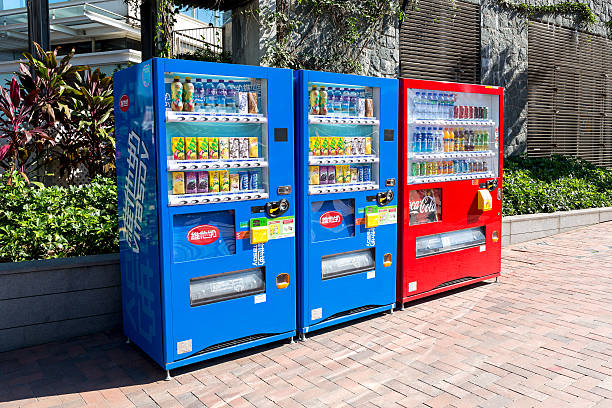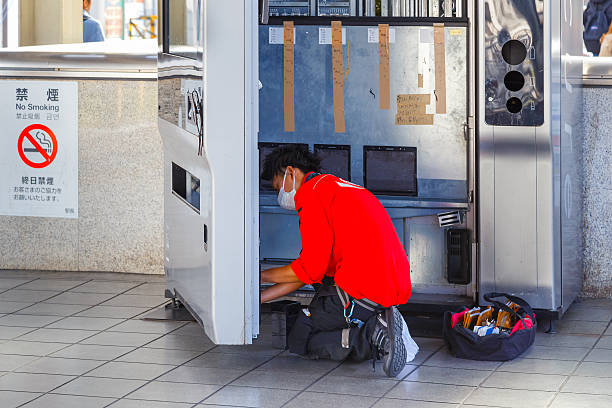What Is a Vending Management System and Its Benefits - GOBEAR
Learn how a vending management system improves efficiency, boosts sales, and cuts costs for vending operators of all siz...
For vending operators, every minute of downtime affects sales and customer trust. In this guide, you’ll learn how to build simple preventive routines that keep your machines running smoothly day to day. With steady upkeep, your machines stay reliable, your margins stay steady, and your customers keep coming back.

Proactive vending machine maintenance is a reliable way to protect your profit and keep your operation running smoothly. When you make maintenance part of your schedule, your machines stay online more consistently, your locations perform more predictably, and day-to-day management feels more controlled.
By planning routine inspections, part replacements, and software updates ahead of time, you reduce the chance of sudden breakdowns that interrupt sales. When your machines stay clean, calibrated, and functioning as intended, they deliver steadier income. A consistent maintenance rhythm helps you stay ahead of issues instead of reacting to them after they cause downtime. This approach keeps performance stable and your workload manageable.
Customers return to machines that work smoothly. If your machines dispense products properly, accept payments without hesitation, and present a clean appearance, people feel comfortable using them again. Reliable performance creates familiarity and trust, which encourages frequent use. Small issues like a jam or payment refusal can quickly change buying behavior. Maintaining the machine well helps keep customers engaged and confident.
It helps to treat maintenance as a planned operating expense rather than something you handle only when problems occur. Spreading maintenance throughout the year reduces emergency repairs and unexpected downtime. This supports a more stable financial outlook and makes your operation easier to expand. Well-maintained equipment runs longer and stays reliable across different locations. Addressing minor wear early helps prevent bigger failures later and protects your revenue flow.

Each day, take a quick walkthrough of your machines. Look for dents, cracks, or visible wear so you can address issues while they are still small. Wipe exterior panels and displays to keep the machine looking clean and inviting. Check stock levels to avoid missed sales when popular items run out. Test the coin and bill acceptors to confirm smooth payment flow and prevent slowdowns at the moment of purchase.
Once a week, clean inside the machine more thoroughly. Remove dust, crumbs, or packaging pieces from shelves and moving parts so the vending mechanism operates smoothly. Run a few test vends to check for consistent product delivery. Clean sensors and clear any developing jams in the payment system to reduce the chance of mid-week service interruptions.
Each month, focus on components that influence efficiency. Clean refrigeration coils, trays, and cooling units to maintain steady temperature control and reduce strain on the system. Inspect wiring and connectors for discoloration or looseness, which can signal early wear. Update the machine’s software when updates are available to keep systems secure and functioning as intended. Replace filters to maintain healthy airflow and protect internal parts from dust buildup.
Keep a service log for every machine. This helps you notice patterns, such as repeated jams in the same column or recurring payment errors. Schedule routine visual inspections to catch warning signs like condensation buildup or slow cooling response. Review machine performance data to spot changes in sales patterns or cycle times, which can guide you toward targeted maintenance or timely replacement when needed.

Keeping your vending machines clean helps support their lifespan, maintain hygiene standards, and build customer trust. When you follow a consistent cleaning routine, your machines stay reliable, appealing, and easier to maintain over time.
Before you begin, you should disconnect the power to avoid electrical risks while handling internal parts. Wearing disposable gloves helps prevent transferring contaminants, and using non-linting cloths ensures sensitive sensors and mechanisms stay free of fibers. Choosing non-abrasive tools also helps protect the surface finish and keeps the machine looking professional.
Each day, you can focus on the areas customers interact with most. Cleaning buttons, handles, and payment modules with food-safe, non-abrasive agents helps keep the machine hygienic and welcoming. When you use microfiber or single-use cloths, you lift dirt without leaving residue, which supports a cleaner look and better user experience.
Dispensing zones benefit from regular attention. You can use certified cleaning solutions where required, then wipe product shelves on a scheduled basis to prevent buildup. Clearing vents or slots with a soft brush or compressed air keeps airflow consistent and helps the machine deliver products smoothly.
A clean exterior gives customers confidence before they even make a purchase. When you use gentle, non-abrasive cleaners on panels and branding areas, the machine maintains a neat, reliable appearance. Aligning this step with other routine tasks makes it easier to stay consistent.
A clear cleaning schedule helps prevent missed steps. When you define daily, weekly, and monthly tasks and record each session in a log, you create a reference that shows patterns and helps you troubleshoot issues early. Choosing cleaners that are compatible with both the machine’s finish and internal components helps protect the equipment and reduce avoidable wear.
Place AI-powered CaseDIY vending machines in busy venues and offer personalized phone cases printed in just 2 minutes. Enjoy high margins, effortless operations, and a fast ROI with no monthly software fees.

Recurring malfunctions can quickly undermine customer confidence and reduce your revenue. To keep your machines reliable, try diagnosing issues by category and applying targeted fixes. Addressing small faults early helps you avoid costly downtime and unnecessary service calls.
When products get stuck, start with a simple visual inspection of the dispensing track and loading area. Use a flashlight to check for debris, bent guides, or misaligned spirals. Clear any obstructions, straighten the guides, and clean the track thoroughly. Once reassembled, test with the actual product you’re vending. If the same SKU jams often, look at the packaging shape and consider adjusting the coil spacing or drop angle to match it better.
If customers can’t pay, sales stop immediately—so treat payment issues as priority items. Troubleshoot in this order:
(1) Inspect coin and bill paths for stuck items or dust.
(2) Clean validator sensors with a recommended cleaning card or swab.
(3) Make sure the card reader and validator cables are firmly connected and corrosion-free.
(4) Confirm coin tubes are stocked, since empty tubes can trigger bill rejections.
If the machine still refuses transactions, update the validator firmware or payment tables to maintain compatibility with current currency and card standards.
A blank screen or unresponsive keypad is usually caused by a power or data connection issue. Check the power feed and reseat all connectors first. If components still behave intermittently, replace the display or keypad before they fail completely—partial failures tend to frustrate users and reduce trust. Regular voltage checks help prevent similar issues from recurring.
For refrigerated or frozen units, act quickly when temperatures deviate from the setting. Verify whether the compressor is running normally, check refrigerant levels (where applicable), and confirm thermostat accuracy. Also check airflow paths and door seals. Keeping a simple temperature log helps you catch issues early and avoid product spoilage or health-code violations.
If modules stop communicating, refer to the error codes to identify the affected area. Inspect boards for burnt components, swollen capacitors, or loose solder joints. Measure voltages if you’re equipped to do so. When a board is clearly failing, replace it promptly to prevent additional components from being damaged. Always use OEM or approved replacement boards to maintain reliability and warranty protection.
You can use this workflow as a universal process when diagnosing most vending machine issues, whether they involve product jams, payment systems, displays, or temperature control.
Initial evaluation — Begin with a quick visual check and read any LED indicators or error codes to narrow the issue.
Clear & clean — Remove debris and clean sensors using cleaning cards/swabs (avoid abrasives and strong solvents).
Test — Re-test with real coins, bills, or products to confirm whether the issue is resolved.
Power cycle — Reboot the machine to reinitialize components and clear temporary faults.
Inspect wear items — Look for worn belts, gears, or sensors, and replace according to manufacturer guidance.
If unresolved — Record the model, software version, and exact symptoms, then escalate to an authorized technician.
Deciding whether to handle vending machine maintenance in-house or hire professionals depends on factors like cost, control, and service efficiency. Use this comparison to align your choice with your business goals and operational needs.
| Criteria | DIY (In-house) | Hiring a Pro (Outsource) |
|---|---|---|
| Cost Considerations | Saves on service fees, but training and mistakes may add costs. | Higher upfront cost, but reduces downtime and protects revenue through preventive maintenance. |
| Control, Flexibility, and Operational Impact | Immediate action, especially during peak sales periods, but pulls staff from core tasks. | Fixed schedules and less flexibility, but ensures uptime without burdening internal resources. |
| Expertise, Tools, and Risk Management | Handles cleaning, restocking, and minor issues, but complex repairs are missed. | Provides expert diagnostics, specialized repairs, and preventive strategies with warranties to reduce risk and downtime. |
You can handle routine cleaning and restocking in-house to save costs and improve efficiency. For more complex tasks like electrical repairs, refrigeration issues, or payment system fixes, it’s best to rely on professional services. For high-traffic or revenue-critical locations, a balanced approach—combining both DIY and expert services—works best. This ensures maximum uptime while avoiding overburdening your internal team.
Consistent upkeep keeps your machines running smoothly and your revenue steady. By following simple daily, weekly, and monthly routines for cleaning, inspections, and calibration, you stop small issues before they disrupt sales. Reliable logs and remote monitoring help you spot changes early and maintain performance across every location.
If you are exploring ways to grow your vending machine business, CASE DIY offers high-quality vending machines built specifically for customizable phone case retail. Our machines focus on easy operation, clear user experience, and straightforward maintenance, making them a practical choice for operators who value uptime and customer satisfaction.
Ready to improve performance and grow your vending network? Contact CASE DIY to get started.
You can check your machines once a week for jams, cleanliness, and general function. Schedule deeper servicing such as component checks, software updates, and sensor calibration on a monthly or seasonal basis, depending on traffic. A steady routine helps you prevent downtime and avoid rushed repairs.
You may run into product jams, sensor misreads, or payment interruptions. Over time, motors, belts, or coils can wear and affect dispensing. Software settings can also slip out of alignment and impact transactions. Noticing these patterns early helps you respond quickly and maintain reliability.
Turn the power off before touching any dispensing parts. Free the item gently to avoid bending guides or spirals. If the jam seems deeper or parts feel tight, it is safer to follow the machine’s manual or contact support instead of forcing anything and creating a larger repair need.
You can manage routine cleaning, restocking, and visual checks yourself. For part replacement, electrical work, or software-related troubleshooting, calling a qualified technician protects both safety and equipment life. Even with systems like CASE DIY designed to simplify upkeep, occasional professional servicing ensures long-term performance.
You can wipe exterior surfaces with a soft cloth and mild cleaning solution to maintain a clean appearance. Avoid abrasive products so screens, decals, and branding stay intact. Pay careful attention to payment modules and product contact points to keep them hygienic and working smoothly.
Tell us about your business goals, and our experts will provide a tailored solution and a detailed profitability report. Let's start building your new revenue stream together.